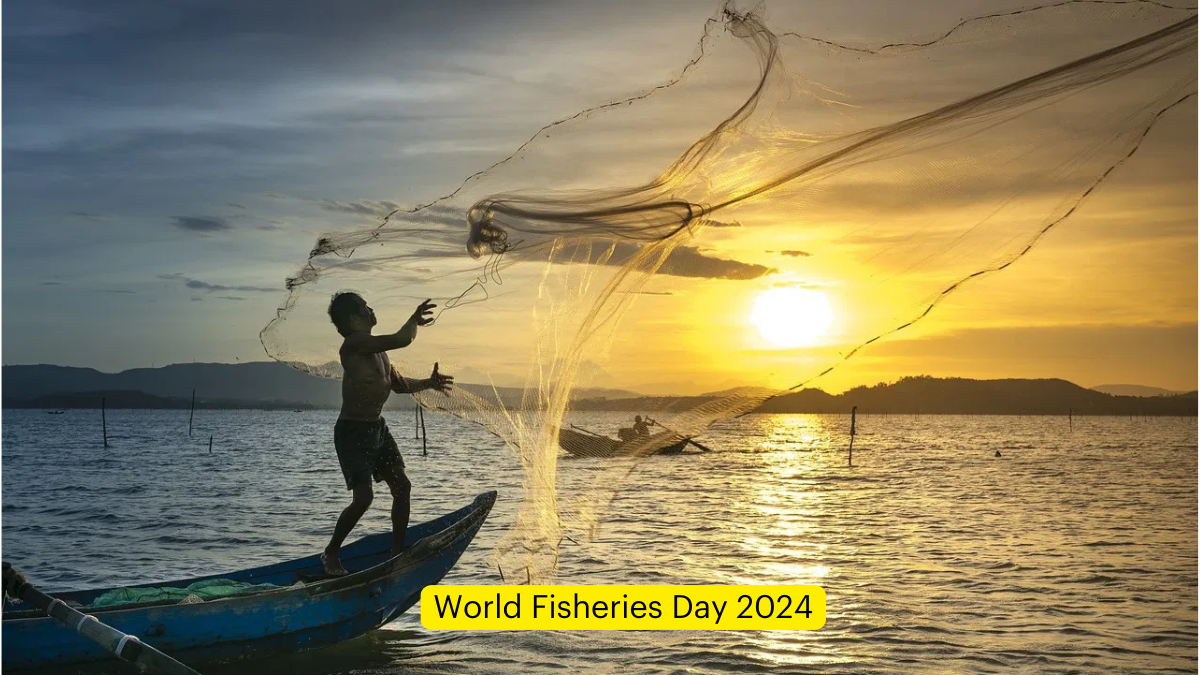World Fisheries Day is celebrated globally every year on November 21 to highlight the importance of sustainable fisheries, the protection of aquatic ecosystems, and the livelihoods of fishing communities. This day is significant in raising awareness about threats such as overfishing, habitat destruction, and illegal fishing practices. Additionally, it emphasizes empowering small-scale fishers, often among the most marginalized communities worldwide.
The origin of this celebration dates back to 1997 when the World Forum of Fish Harvesters & Fish Workers was established in New Delhi, India. Representatives from 18 countries formed the World Fisheries Forum, advocating for sustainable fishing practices and policies globally.
Importance of Fisheries in India
India plays a pivotal role in the global fisheries landscape, being the 3rd largest fish producer and the 2nd largest aquaculture nation after China. With its status as the largest shrimp producer, India significantly contributes to domestic food security and the global seafood market. The fisheries sector supports the livelihoods of approximately 30 million people, primarily in coastal and rural communities.
India’s fisheries sector has experienced a remarkable transition from being marine-dominated to focusing on inland fisheries. The shift from capture fisheries to culture-based aquaculture has driven India’s blue economy, promoting sustainability and growth.
India Celebrates World Fisheries Day 2024
Theme for 2024
This year’s theme is “India’s Blue Transformation: Strengthening Small-Scale and Sustainable Fisheries,” underscoring India’s commitment to inclusive growth and sustainable practices in the sector.
Celebrations and Initiatives
The Department of Fisheries (DoF) under the Ministry of Fisheries, Animal Husbandry and Dairying (MoFAH&D) will host the event on November 21, 2024, at Sushma Swaraj Bhawan, New Delhi. The Union Minister, Shri Rajiv Ranjan Singh alias Lalan Singh, will preside over the occasion.
Key Initiatives to be Launched:
- 5th Marine Fisheries Census: Aiming for data-driven policymaking to better understand marine resources.
- National Plan of Action (NPOA) on Sharks: Focused on conserving shark species.
- Bay of Bengal-Regional Plan of Action (BoB-RPOA): Targeting illegal, unreported, and unregulated (IUU) fishing.
- IMO-FAO GloLitter Partnership Project: Addressing marine plastic pollution.
- Retrofitted LPG Kits: Promoting energy-efficient fishing practices.
- Single Window System for Coastal Aquaculture: Simplified online registration for coastal aquaculture farms.
- Voluntary Carbon Market Framework: Introducing carbon trading mechanisms within the fisheries sector.
Technical Sessions:
- South-South and Triangular Cooperation: Discussing sustainable fisheries and food security.
- Climate Change Challenges in Fisheries: Addressing mitigation strategies and opportunities like carbon credits, plastic management, and traceability in fisheries.
Awards and Recognition
Progressive States/UTs, individuals, and entrepreneurs contributing to the growth of Indian fisheries and aquaculture will be honoured during the event.
India’s Global Leadership in Fisheries
Position in Global Fisheries
India’s fisheries sector is recognized as a “sunrise sector,” contributing significantly to the global food system.
- 3rd largest fish producer in the world.
- 2nd largest aquaculture nation.
- Largest shrimp producer globally.
Growth in Fish Production
India’s total fish production has seen a dramatic rise, with 70% now coming from inland fisheries, transitioning from a marine-dominated industry.
- Aquaculture Productivity: Increased focus on culture-based practices.
- Brackish and Saline Aquaculture: Significant growth in shrimp farming and untapped potential in saline aquaculture zones.
Major Government Schemes and Policies
1. Blue Revolution Integrated Development and Management Fisheries Scheme
- Launched in 2015-16 to enhance fish production and productivity.
- Focuses on marine and inland fisheries.
2. Pradhan Mantri Matsya Sampada Yojana (PMMSY)
- Launched in 2020 with an aim to double fisheries exports to ₹1 lakh crore and create 55 lakh jobs.
- Emphasizes increasing aquaculture productivity from 3 tonnes/ha to 5 tonnes/ha.
3. Fisheries and Aquaculture Infrastructure Development Fund (FIDF)
- Introduced in 2018-19 to fund infrastructure projects with up to 3% interest subvention.
4. ICAR-Central Institute of Fisheries Education (CIFE): A Centre of Excellence
- Established in 1961, CIFE has trained over 4,000 fisheries professionals.
- Focuses on research and capacity building in sustainable aquaculture practices.
Promoting Sustainable Fishing in India
Regulatory and Conservation Measures
- National Policy on Marine Fisheries (NPMF, 2017): Aims to ensure sustainability in marine fisheries.
- Fishing Ban: A 61-day monsoon ban to allow replenishment of fish stocks.
- Prohibition of Destructive Practices: Bans on pair trawling, LED lights, and bull trawling.
- Promotion of Sea Ranching and Artificial Reefs: Encouraging sustainable fishing practices.
Climate Resilience in Fisheries
- Development of cold-water fisheries in Himalayan regions.
- Promoting high-value products like omega-rich trout.
- Mitigation strategies against climate change impacts.
Investments in the Sector
The Department of Fisheries has seen historic budget allocations, including ₹2,584.50 crore for FY 2024-25, marking a 15% increase over the previous year. This investment supports:
- Expansion of inland fisheries.
- Infrastructure development under PMMSY and FIDF.
- Research and technology infusion for sustainable aquaculture.
Summary of World Fisheries Day 2024
| Category | Details |
|---|---|
| Why in News? | World Fisheries Day 2024 is celebrated on November 21, highlighting sustainable fisheries, protecting aquatic ecosystems, and empowering fishing communities. |
| Theme 2024 | “India’s Blue Transformation: Strengthening Small-Scale and Sustainable Fisheries” |
| Event Location | Sushma Swaraj Bhawan, New Delhi |
| Presiding Minister | Shri Rajiv Ranjan Singh alias Lalan Singh, Union Minister of Fisheries, Animal Husbandry & Dairying |
| Key Initiatives Launched | – 5th Marine Fisheries Census: Data-driven policymaking – National Plan of Action (NPOA) on Sharks: Shark conservation – Bay of Bengal-Regional Plan of Action (BoB-RPOA): Tackling IUU fishing – GloLitter Partnership Project: Addressing marine plastic pollution |
| – Single Window System: Simplified online registration for coastal aquaculture – Voluntary Carbon Market: Introducing carbon trading in fisheries – Retrofitted LPG Kits: Promoting energy-efficient practices |
|
| India’s Global Leadership | – 3rd largest fish producer globally – 2nd largest aquaculture nation after China – Largest shrimp producer worldwide |
| Growth in Fisheries | – Inland fisheries contribute 70% of total production – Shift from marine to aquaculture-based practices – Expansion of brackish and saline aquaculture (e.g., shrimp farming). |
| Major Schemes | 1. Blue Revolution Scheme (2015-16): Enhanced fish production 2. PMMSY (2020): Doubling fishery exports and creating 55 lakh jobs 3. FIDF (2018-19): Infrastructure funding with 3% interest subvention. |
| Budget Allocation FY 2024-25 | ₹2,584.50 crore (15% increase) to support PMMSY, FIDF, and other sustainable fisheries initiatives. |
| Promoting Sustainability | – Fishing Ban: 61-day monsoon ban – Marine Fishing Regulation Act (MFRA): Zonation, gear size regulations – National Policy on Marine Fisheries (NPMF 2017): Focus on sustainability – Sea Ranching and Artificial Reefs: Promoting ecosystem recovery. |



 National Energy Conservation Day 2025: M...
National Energy Conservation Day 2025: M...
 International Day Against Colonialism in...
International Day Against Colonialism in...
 International Day of Neutrality (12 Dece...
International Day of Neutrality (12 Dece...







